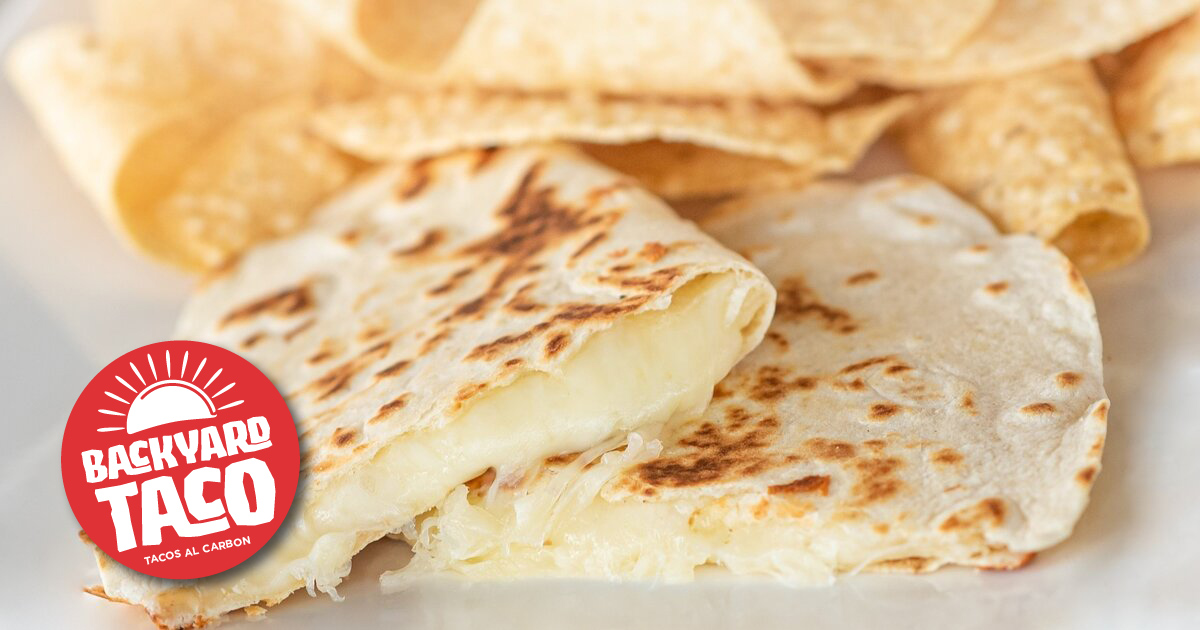 Photo from backyardtaco
Photo from backyardtaco
Originally Posted On: Where Did the Quesadilla Originate? | History of the Quesadilla (backyardtaco.com)
¡Hola, amantes de la comida! Hello Foodies!
Of the variety of dishes offered in Mexican cuisine, the quesadilla has a special place in many of our stomachs. It is considered an authentic dish with its roots in Mexico, though it has been adopted by many cultures throughout the world. Quesadillas around the world have taken the possibilities for flavor to numerous different levels over the long life of this famous food item. Over time, the most used recipes have been adapted to different styles as well. We all enjoy the quesadilla as it is today in our restaurants, but we should look into the origins of the quesadilla as well.
Quesadillas fit right in with the other most famous Mexican food items at family dinner whether you are cooking with some influence from south of the border, or if you are out to eat with us at Backyard Taco and giving some of our different types of quesadillas a try!
Keep reading to discover the origins of this tasty authentic dish.
WHERE DID THE QUESADILLA ORIGINATE?
 Photo from gettyimages
Photo from gettyimages
The quesadilla found its long-lasting place in the kitchens of humanity in colonial Mexico. Many believe that the quesadilla was brought to the West by Spain, but after deeply reaching the topic, we can confidently say this is not the case. The most authentic Mexican quesadilla originated in the south-central regions of the Mexico!
Let’s take a look at the components of the authentic quesadillas, and our perspective on how different cultural influences came together in the manifestation of the now famous food that many love all over the world.
TORTILLA
The tortilla, a flat circle of corn masa that has been previously cooked would be warmed up and softened to the point that it could be folded up. The word itself means “little cake.” The corn tortilla is credited to first have been consumed by Native Americans in pre-Columbian times as those natives were efficient agriculturists, especially in the art of growing and harvesting maize.
Eventually, the flour tortilla became extremely common in quesadillas and other foods in Mexican cuisine. Flour tortillas were inspired by corn tortillas but are made of wheat flour in place of corn. Popularity of corn tortillas was undisputed for a long time, but the rise of flour tortillas became more popular as wheat became a more commonly harvested part of agriculture.
CHEESE
The space that forms by the folding of the tortilla is the incredibly valuable pocket that acts as a vehicle for the other ingredients that will fill in it. The Monterey jack cheese that you will find in the quesadillas on our menu is fairly similar to the Oaxaca cheese you would find filling these traditional masa tortillas. Oaxaca cheese is stringy, semi-hard, and white. Its texture is similar to mozzarella and melts similarly, as well. This cheese is produced by a method called curd-stringing, which was introduced to Mexicans by Dominican monks.
MEATS
As early as the 1500s, Spain began introducing pork and beef into commonality for the indigenous people. Before the conquistadores and other explorers, meat was not nearly as ubiquitous in Latin American diets as it is today. While it would not be common earlier on in Mexican culture, different meats would have joined the Oaxaca cheese over time.
OTHER INGREDIENTS USED IN QUESADILLAS
In addition to meat and cheese, other ingredients have found their way into the traditional quesadilla from the rich variety of foods found in the Mexican food culture, such as:
- Cooked beans
- Epazote
- Chicharron
- Salsas
- Harvest vegetables
The Aztecs were already used to using tortillas as the vehicle for a number of different food items that they were harvesting. Masters of managing agriculture in a wide variety of climates in their area, from jungle to arid plain, many vegetables were grown and consumed for the Aztec communities. We know that the Aztecs grew and ate squashes which would be cooked and mashed into a pastry texture. Then, they would take them and stuff corn tortillas full and bake them in clay ovens to cook them as sweeter food items.
Once filled, the Mexican quesadilla would be cooked on a smooth, flat griddle called a comal, until the Oaxaca cheese was melted, and the tortilla was slightly crispy.
THE MODERN QUESADILLA
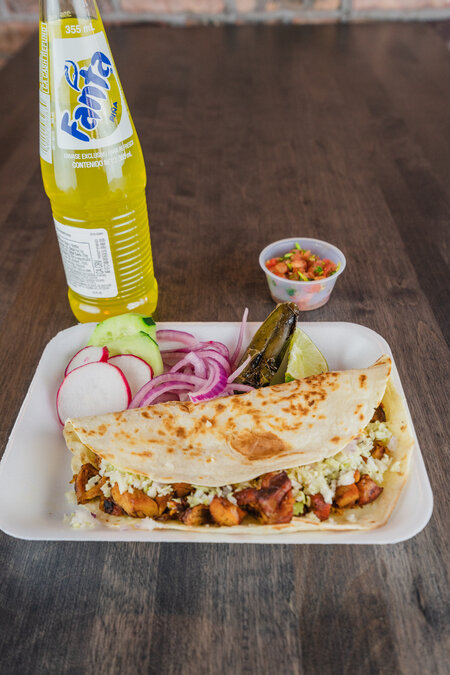
When we take a look at a classic meat and cheese quesadilla one piece at a time, we realize that it was always a multicultural food, thanks to North American Natives, Italian monks, Spanish explorers, and Mexican Natives. Today, quesadillas have found their way onto menus all over the world, especially in the Southwest of the United States.
All over the country you will find numerous adaptations to the quesadilla, for any meal. One popular option is the breakfast quesadilla, where a fried egg with avocado might be included in the tortilla. Fillings can vary for folks with different diets as well, perhaps with spicy black beans or tofu for the vegetarian, where steak or seafood might be more appealing to others. Truly, anything can fill the space provided by a folded tortilla when melted cheese is there to hold it together!
On our Menu at Backyard Taco, you will find numerous variations of the quesadilla. You are welcome to meet your standard of a classic quesadilla with just Monterey jack as the filling, but we also offer them with our delicious al pastor and shredded beef, matched with red onion and cilantro, forming a nicely balanced flavor that your soul will thank you for after the first bite.

Al Pastor Quesadilla
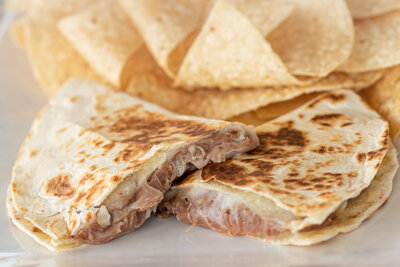
Bean and Cheese Quesadilla
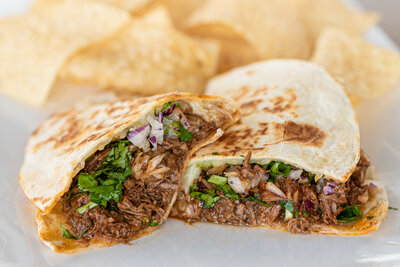
Birria Quesadilla
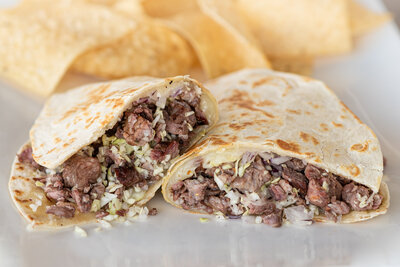
Carne Asada Quesadilla
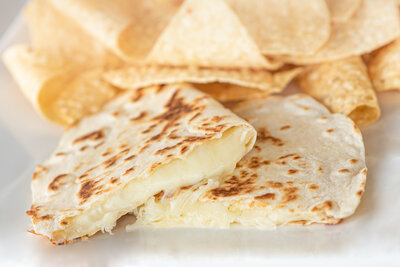
Cheese Quesadilla
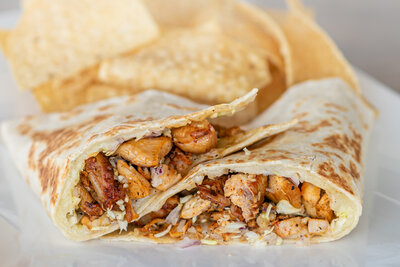
Chicken Quesadilla
WHY IS IT QUESADILLA AND NOT QUESODILLA?
In the Spanish language, the word queso translates to the English cheese, and “dilla” is (out of context) a slang term in English for “dude.” So, our beloved quesadilla is, in fact, the cheese-dude! Realistically, the “illa” ending translates closely to “little thing,” so “little cheesy thing” would be a more correct (and logical) translation. The reason that there is an “a” in quesadilla instead of an “o” is simply a linguistic habit that evolved in spelling to match with the “dilla” ending common in Mexican nouns.
To avoid confusion about the cheese used in a quesadilla, and the queso you might dip chips in at Mexican restaurants, that creamy cheese dip is not what we are filling our quesadillas with. Queso dip is often made with cheddar cheese and sour cream, which gives it a much different flavor and texture than the traditional Oaxaca cheese or even the Monterey jack cheese that you will find in our quesadillas at Backyard Taco. Other queso dip recipes use cotija which would give it a tangier flavor.
WHY ARE MEXICAN QUESADILLAS IMPORTANT?
Whether or not you are at a dinner restaurant and have a quesadilla on the plate in front of you regularly or not, this favorite from the Mexican cuisine will always have a reputation in our human culture. Plenty of food items have found their way across the globe, for better or for worse, but humans around the world can agree that the quesadilla will be around for a while. As time goes on, maybe we can learn from the multicultural background of the quesadilla’s history and create other lovable foods from combining authentic ingredients together.
If you are looking for something to do at home that is easy, customizable, and will likely satisfy the whole family or all your friends, try having a quesadilla bar for your next family dinner, dinner party, or grill-out. Try out different cheeses, meats, mushrooms, vegetables, salsas, sauces, and dips to find your favorite combinations and bring the next favorite version of the quesadilla into the world.
If you don’t want to spend time in the kitchen, get your next fiesta catered by Backyard Taco instead! We can create an awesome, memorable experience and elevate your party platters. Quesadillas and salsa bar included! Contact us to discuss your next event!